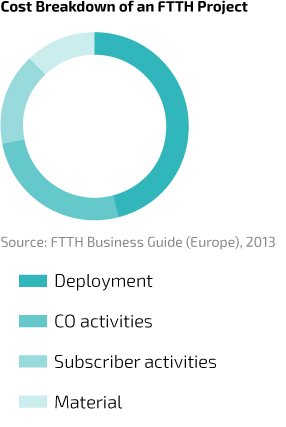“When planning a project there are several factors which are important to take into account. One is the labour cost of FTTH deployment projects. Civil works can, in some cases, account for as much as 40% or even more of the total cost. The price of labour in different countries can vary enormously. This may completely change the business plan and might result in the network operator rolling out more - or less - infrastructure. It is also important to know exactly which infrastructure is in place – if any – and how to make the most of this.”
Smart choices
“In addition, there are different cabling deployment methods to choose from. You can re-use existing ducts, or choose the aerial method or direct buried methods, although the latter tends to be more costly. In different countries, there are different possibilities and limitations. In Russia, aerial cabling is used quite a lot, whereas in Western Europe this is generally not recommended. When choosing a deployment method, it is important to look at the bigger picture. For example the cabling price might seem low, but if a cable is difficult to be maintained in the field during the operations, you may end up spending more.”
“Researching the size and type of demand is another key to a successful rollout. How long will it take to recoup the investment at existing levels of demand? Is demand initially limited but expected to take off? How might this affect your Capex and Opex? If you try and save too much money at the outset, you might encounter significant additional costs when accommodating future requirements. These considerations should be part of strategic planning, and this, in turn, requires input. We recommend tool-based planning, if possible with GIS - Geographic Information System – data and, again, explicit and consistent documentation.”
Three key points
“Strategic planning at the start of a project can minimise the effort required to operate and maintain the network later. To enable more efficient network operations and maintenance, the deployment strategy can be optimised. Clear network design rules are a must. Considerations include the provision of spare capacity for network additions and extensions, required flexibility and accessibility of cables and conduits, and future migration strategy.” “To keep the network manageable and avoid unnecessary errors and repair downtimes, well-maintained network documentation is vital. Overall, this saves time and cost during the network operation and maintenance phase. Standardised process management provides a set of proven and effective practices to support network operations and maintenance in a systematic way, while increasing the efficiency of all related procedures and tasks.
Technical aspects of fibre networks
The FTTH council Deployment & Operations Committee discusses all technical aspects of fibre networks. This includes the passive and active part of the network as well as the deployment methods, network architectures and new fibre technologies. The Deployment & Operations Committee has created white papers in the last year on new technologies and innovations and innovative FTTH deployment technologies. The Committee is also responsible for producing and revising the FTTH Handbook, which was created a few years ago to help network operators understand the options available for fibre access network infrastructure.
Build to finance
“The FTTH Council Europe does not have a preference for any specific financing model, as every project is different.

Size, regulation and competition are just a few of the parameters that can influence the choice of financing model. However, it is increasingly obvious that any type of financing model also requires a sound business model. In this context, it is advisable to look at passive infrastructure (ducts, poles, cables and so on) as an investable asset class. This would result in a wholesale-driven business model, as used in the realestate sector. Generally speaking, the financing model should never come as an afterthought. It should be an integral part of the business case modelling – ‘Build to finance’ is key.”
“When we look at technologies, there are many options. Here, too, the best choice depends on local or regional geographical specifics. The choice of technology should, however, enable capacity upgrades at minimal future cost. Deploying and financing FTTH networks in rural areas is much more difficult than in urban areas. However, the socioeconomic impact can be higher.” “Low population densities can present a challenge – hence the strong demand for public subsidies. The question is: what mechanism should be used to channel public funds to projects? Gap funding* is one model and investing in (partly) publicly owned passive infrastructure is another. Every model has its advantages and disadvantages but we have come to the conclusion that gap funding models have a tendency to not be operator and technology neutral. Likewise, one can argue that gap funding models may lead to an inefficient use of taxpayers´ money.”
Thomas Langer, Finance Consultant, FTTH Council Europe
* With regard to state aid the gap funding model is the most commonly used. How it works: the operator calculates revenues and costs in a specific rollout area and calculates a deficit. This delta is covered by the government, in return for an obligation by the operator over a seven-year period.
Downloads
Operational Efficiency in FTTH Networks
Innovative FTTH Deployment Technologies

